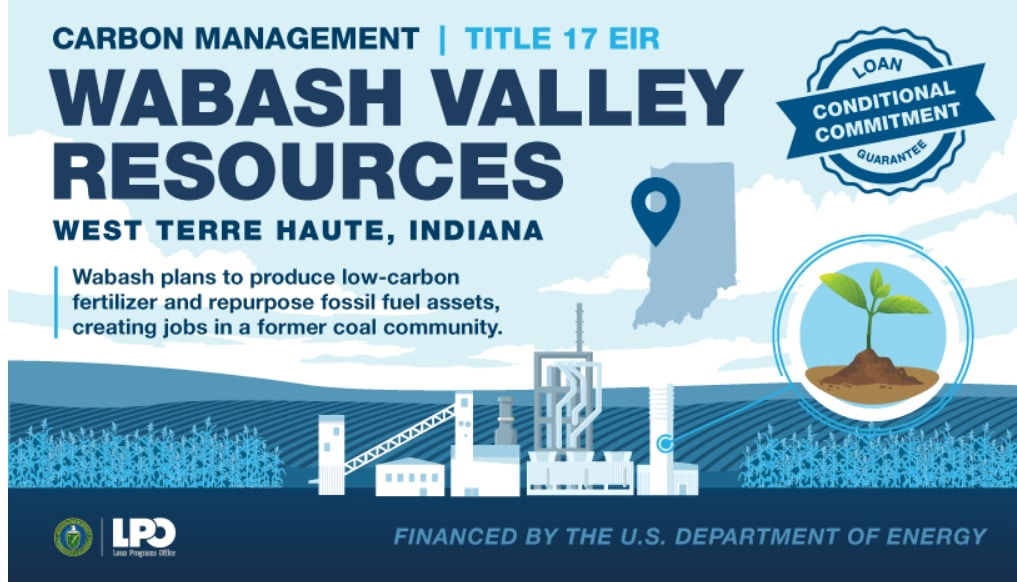The U.S. Department of Energy’s (DOE) Loan Programs Office (LPO) announced a $1.559 billion conditional commitment loan to Wabash Valley Resources, LLC. The loan guarantee will help finance the construction of a groundbreaking waste-to-ammonia production facility in West Terre Haute, Indiana. Notably, this investment is a part of the Biden-Harris Administration’s Investing in America agenda.
Wabash Valley’s Cutting-Edge Carbon-Capture Ammonia Project
Ammonia plays a crucial role in U.S. agriculture, especially for farmers in the Midwest’s Corn Belt who rely on nitrogen fertilizers to grow their crops. However, producing ammonia has traditionally been an energy-intensive process that contributes to 1-2% of global carbon emissions.
Wabash Valley Resources is stepping up with a new approach to meet the growing demand while cutting down on harmful environmental impacts. Thus, this Indiana project aims to secure a local low-carbon supply of ammonia that will reduce the region’s dependence on imports and mitigate emissions simultaneously.
- They expect the plant to capture 1.65 million tons of carbon dioxide annually once fully operational.
The key attributes of the project are:
- Repurpose an industrial gasifier to process petroleum (pet) coke, a waste byproduct from oil refining, and convert it into 500,000 MTS of anhydrous ammonia annually.
- Utilize carbon capture and sequestration (CCS) technology to permanently store carbon dioxide, significantly reducing emissions.
Wabash Valley Resources is investing in cutting-edge technology to reduce the need for imported fertilizer in the Eastern Corn Belt. The new ammonia facility will replace a former coal plant and use nearby closed coal mines to store carbon dioxide, creating new opportunities in that region. Furthermore, they aim to make this the largest carbon sink in the U.S. and a model for zero-carbon fertilizer production.
In addition to the environmental benefits, the project is set to provide a significant economic boost, improving the livelihood of farmers and several other community benefits to West Terre Haute and the surrounding region.
Job Boost and Economic Growth
The press release highlights that, “With an investment of $2.4 billion—bolstered by DOE’s $1.559 billion loan guarantee—the facility will create an estimated 500 construction jobs and 125 permanent operational positions.”
A third-party analysis predicts the project will create 1,100 more permanent jobs, boosting the local economy. These will be high-quality union jobs, offering fair wages and benefits to workers. They also plan to hire hundreds of construction workers and invest nearly $900 million in this innovative project. Once fully operational, the facility will employ 125 skilled team members exclusively.
This initiative aligns with the Biden-Harris Administration’s goal to create quality jobs, especially in communities that once depended on declining industries.
Securing Food Supply and Reducing Volatility
Farmers residing in the Midwestern region often deal with unpredictable fertilizer prices driven by global events. For example, the Russian invasion of Ukraine caused ammonia prices to soar, adding strain on U.S. farmers. Even currently, the region relies heavily on Canadian and overseas imports for nitrogen fertilizers.
The new facility offers a local, cost-effective alternative to imported ammonia, helping to stabilize fertilizer prices. Overall, this domestic boost will protect U.S. agriculture from global market fluctuations, secure critical supply chains, and strengthen food security.
Environmental and Community Benefits
Beyond stabilizing the agricultural supply chain, this project aligns with the Biden-Harris Administration’s Justice40 Initiative, which aims to direct 40% of the benefits of federal climate and clean energy investments to less privileged communities.
Wabash Valley Resources is taking a proactive approach to ensuring that the benefits of this facility extend to the local population, particularly in Vigo County, Indiana, where the project is located. In this perspective, they have
- Developed a comprehensive Community Benefits Plan (CBP) to create good-paying jobs, enhance community well-being, and minimize environmental impacts.
- Engaged with the community and collaborated with stakeholders, including the Central Wabash Valley Building and Construction Trades Council.
- Committed to redeveloping the 50-acre brownfield site, supporting Indiana’s efforts to revitalize local communities.
In addition to economic development, Wabash Valley Resources is partnering with local institutions like Rose-Hulman Institute of Technology, Indiana State University, and Ivy Tech Community College to develop training programs that will equip workers with the necessary skills to operate the facility. This effort reflects the administration’s commitment to building an inclusive clean energy workforce.
Aligning with DOE’s Energy Infrastructure Reinvestment (EIR) Program
The Wabash Valley Resources project turns pet coke—a waste product typically burned in low-income countries—into ammonia, cutting emissions and offering a sustainable alternative. By sequestering carbon and investing in clean technologies, this initiative aligns with the DOE’s Energy Infrastructure Reinvestment (EIR) program which is authorized by the Inflation Reduction Act.
Through this program, they can repurpose outdated energy infrastructure for cleaner uses and reduce industrial emissions. In essence, this project embodies the Biden-Harris Administration’s dedication to a cleaner, more sustainable future, ensuring that all communities benefit from the transition.
However, since DOE’s commitment to financing the project is conditional, both parties need to meet specific technical, legal, environmental, and financial requirements before finalizing the loan. All in all, we look forward to finalizing this commitment, allowing Wabash Valley Resources to transform the ammonia production landscape.

